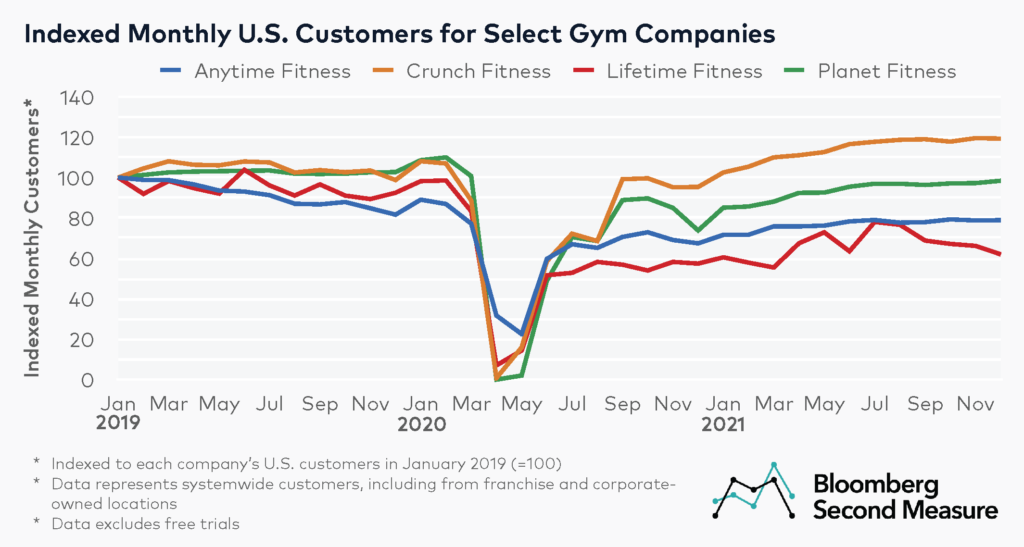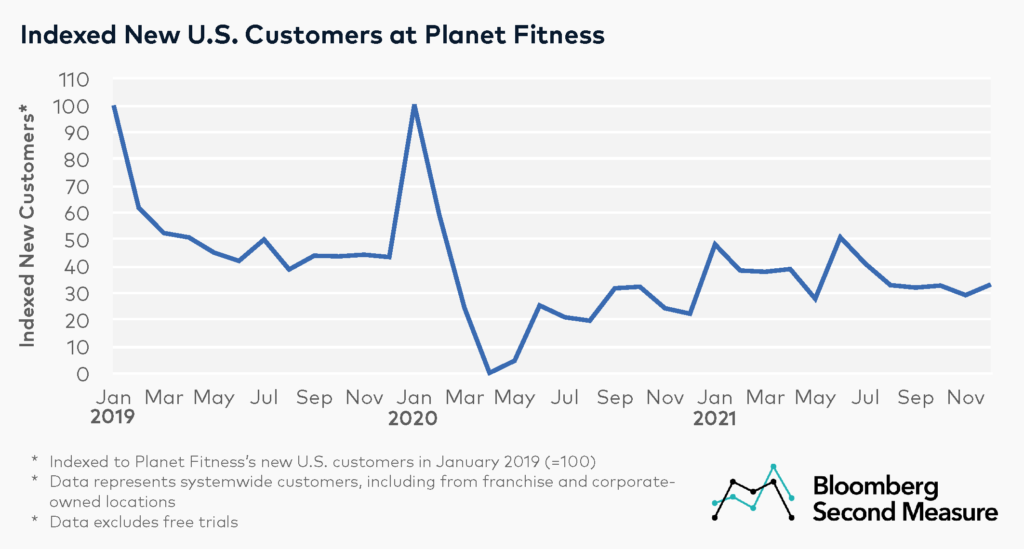NOTE: Bloomberg Second Measure launched a new and exclusive transaction dataset in July 2022. Our data continues to be broadly representative of U.S. consumers. As a result of this panel change, however, we recommend using only the latest posts in assessing metrics, and do not support referring to historical blog posts to infer period-over-period comparisons.
After sweating out the early months of COVID-19, several national gym chains are finally experiencing a healthy increase in membership levels. Our competitive analysis of gym companies illustrates that U.S. customer counts steadily increased throughout 2021, and memberships at gym chains such as Crunch Fitness, Planet Fitness, and Anytime Fitness almost reached or exceeded pre-pandemic levels. Consumer transaction data further shows that Planet Fitness (NYSE: PLNT) continues to experience a significant spike in new customers every January, corresponding with the popular New Year’s resolutions to get fit or live a healthier lifestyle.
Crunch Fitness members have exceeded pre-pandemic levels
Members have been running back to some gym chains, while for other chains, recovery is at a slower pace. Looking at select gym chains—Life Time Fitness (NYSE: LTH), Planet Fitness, Anytime Fitness, and Crunch Fitness—U.S. customer counts warmed up in late 2020 through 2021, after a brief period in spring 2020 when memberships were on hiatus. Notably, free trials are excluded from our data.

Among the companies in our competitive analysis, Crunch Fitness saw the most customer growth. In December 2021, U.S. customer counts were 21 percent higher than the same month in 2019. At Crunch, members can pay on a month-to-month basis or as an annual upfront payment. Crunch executives have reportedly cited that some likely reasons for the company’s growing customer base during the pandemic include the fitness franchise’s digital workout offerings, the desire to return to a gym community, and weight gain during quarantine.
Planet Fitness and Anytime Fitness have also been closing the gap between pre-pandemic and COVID-era customer counts. In December 2021, Planet Fitness had 4 percent fewer customers than in December 2019. Likewise, U.S. customer counts at Anytime Fitness were down 3 percent across the same time frame.
Other gym chains, like Life Time Fitness, have experienced slower customer growth. Life Time Fitness’ customer counts in December 2021 were 33 percent lower than in December 2019. The fitness company went public again via an IPO in October 2021, after being taken private in 2015.
Planet Fitness (NYSE: PLNT) sees an increase in new customers each January
Zooming in on Planet Fitness, new memberships spike in January of each year. New Year’s resolutions could be one of the factors behind the spike in new customers, as many consumers resolve to get in shape.

Prior to the pandemic, the volume of new U.S. memberships at Planet Fitness in January was about twice the level as every other month of the year. New customer counts remained steady in January 2019 and January 2020. However, new customer counts in January 2021 were down 52 percent compared to the same month in 2019 and 2020.
For most months in 2021, new membership levels were lower than before the pandemic. The exception to this trend was June 2021, which saw a 21 percent increase in new customers compared to June 2019. Potential factors for this summer jump in new customers include increased vaccination rates and reduced restrictions on mask-wearing at fitness facilities.
Planet Fitness customers can choose between two membership options: the Classic membership, which starts at $10 per month, and the PF Black Card membership, which generally ranges between $20 and $25 depending on location. While some gym chains require an annual contract, Planet Fitness plans are on a month-to-month basis.
In recent months, Planet Fitness has been placing greater emphasis on corporate-owned gyms. In January 2022, the fitness giant announced it would purchase 100 locations from franchisee Sunshine Fitness, thus expanding its corporate-owned portfolio to about 10 percent.
What about home fitness?
When gyms were closed early in the pandemic, U.S. consumer sales for home fitness companies skyrocketed. For example, high demand for Peloton (NASDAQ: PTON) products in 2020 led to supply constraints and increased delivery times. Demand has since declined, and in January 2022, the company announced it was planning to review its production levels and workforce size. Over the past two years, other fitness-related companies also entered the home exercise space for the first time. In 2020, Lululemon (NYSE: LULU) acquired the interactive home gym Mirror, and Equinox Holdings launched an at-home stationary bike based on its popular SoulCycle brand.
At the same time, some home fitness companies have expanded into other categories. Along with selling exercise equipment, many home fitness companies also offer digital health products, like subscriptions for online workout classes, or, in the case of Peloton, their own brands of activewear. Interestingly, many consumers are opting for a hybrid approach to fitness by keeping their gym memberships in addition to using workout equipment at home. The question remains of how consumer preferences may continue to change.
*Note: Bloomberg Second Measure regularly refreshes its panel and methods in order to provide the highest quality data that is broadly representative of U.S. consumers. As a result, we may restate historical data, including our blog content.
